Litterfall and associated macro-zoobenthos showed significant annual production of 13.96 and 10.18 tons per ha
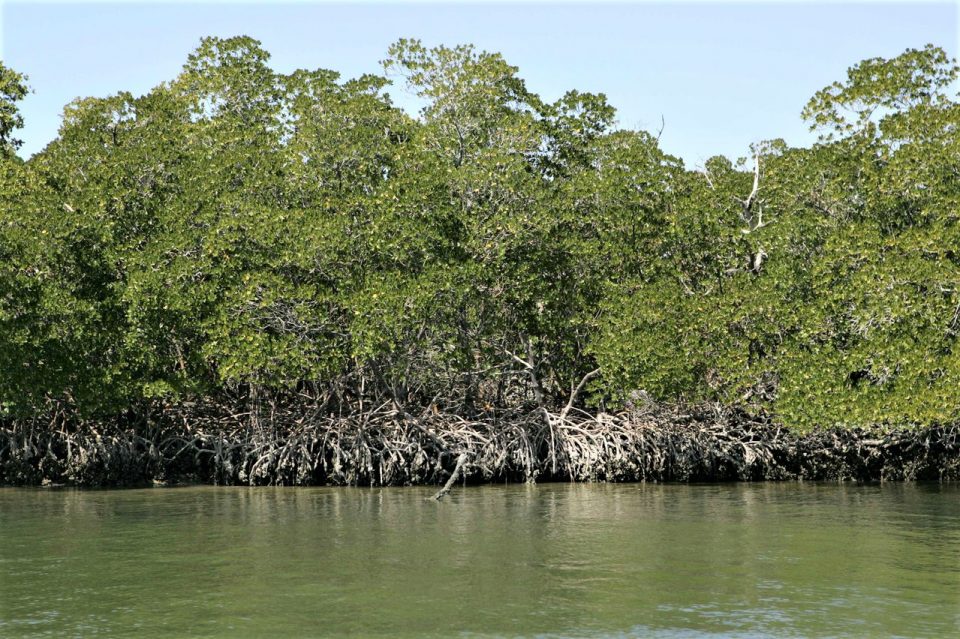
The importance of mangrove forests to reduce the impact of climate change has been highlighted in many studies. Although they cover only 0.5 percent of the global coastal area, the capacity of mangroves to store carbon is one of the highest among other vegetated ecosystems, which are termed “blue carbon.” The largest carbon stock in mangroves lies in their soil pools, accounting for up to 75 percent of total mangrove carbon stock in the system.
The reconversion of abandoned aquaculture ponds to mangroves can be a potential tool for rebuilding carbon stocks of degraded mangroves. In Southeast Asia (SEA) countries, including Indonesia, huge efforts have been made by both governmental and non-governmental actors over the past two decades to conserve and restore mangroves, and most activities are mainly focused on the monoculture plantation of red mangrove (Rhizophora spp.) seedlings.
Relatively high rates of mangrove growth and gains in sediment accretion can be gained when a restoration project takes place in suitable sites and with appropriate methods, which are favorable for ecosystem service provision and climate change mitigation. Thus, the study of the dynamics of mangrove organic matter formation between intact and restored mangrove forests is relevant to understanding changes in forest productivity and evaluating the restoration process.
This article ̶ adapted and summarized from the original publication (Pradisty, N.A. et al. 2022. Litterfall and Associated Macrozoobenthic of Restored Mangrove Forests in Abandoned Aquaculture Ponds. Sustainability 2022, 14(13), 8082) ̶ investigated mangrove litter as the source of carbon in restored mangrove forests in Perancak Estuary, Bali, Indonesia, which previously experienced substantial mangrove loss due to shrimp aquaculture development.
For detailed information on the study site and study design; assessment of plant litterfall production, leaf litter decay and decomposition; macro-zoobenthos [(invertebrates >1 mm living in the sediment or attached to the seafloor] sampling and biodiversity indices assessment; and data analyses, refer to the original publication.
Mangrove litterfall and affecting factors
Our analysis showed that the amount and composition of litterfall varied between the forest types, which may correspond to the differences in maturity stages of mangrove stands, forest structure (i.e., canopy and understory arrangements), soil properties, and tidal elevation. The forest structure of restored mangroves in Perancak Estuary has changed gradually over the years, visually observed by increasing tree diameter and height to fluctuating density (i.e., increasing density during the growth of young stands followed by natural thinning after the stand’s maturation). In early forest stand development, the aboveground net primary production (ANPP) of mangrove stands gradually increases and then declines as stands age. It is also known that a high proportion of mangrove ANPP is shed as litter.
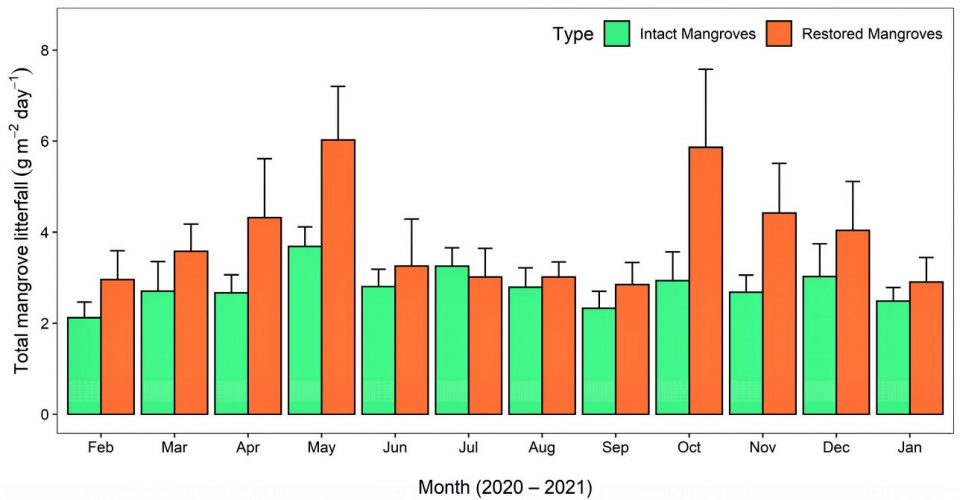
Litterfall input of our study location [13.96 MT per ha per year (restored) and 10.18 MT/ha/year (intact)] lies within the range of tropical mangrove litter production (3–18 MT/ha/year globally, 5–18 MT/ha/year for SEA). Besides forest succession stages (i.e., pioneer plants–young forests–mature forests), forest management (e.g., selective pruning or harvesting) and anthropogenic disturbance (e.g., coastal development) can influence litterfall production.
Moderate litterfall input in Perancak mangroves may correspond to minimum pruning and harvesting activities by the local communities. The litterfall production of intact mangrove forests without significant anthropogenic disturbance from previous studies in the tropical region of both Indo-West Pacific (IWP) and Atlantic-East Pacific (AEP) ranges from 16 to more than 20 MT per ha per year (i.e., Apar-Adang Nature Reserve, Indonesia; Sibuti Mangrove Forest Reserve, Malaysia; and Atrato River Delta, Colombia).
The effect of environmental and climatic variables (porewater salinity, rainfall, wind speed, daylight hours, and air temperature) on litter production varied between intact and restored mangroves (Fig. 2). Our data showed that total litterfall production in intact mangroves was not correlated with environmental variables, but significant correlations were detected in individual litter components, for instance, a positive correlation of rainfall with reproductive parts litter and wood litter, or negative association between reproductive parts litter with a monthly mean of maximum wind speed and porewater salinity.
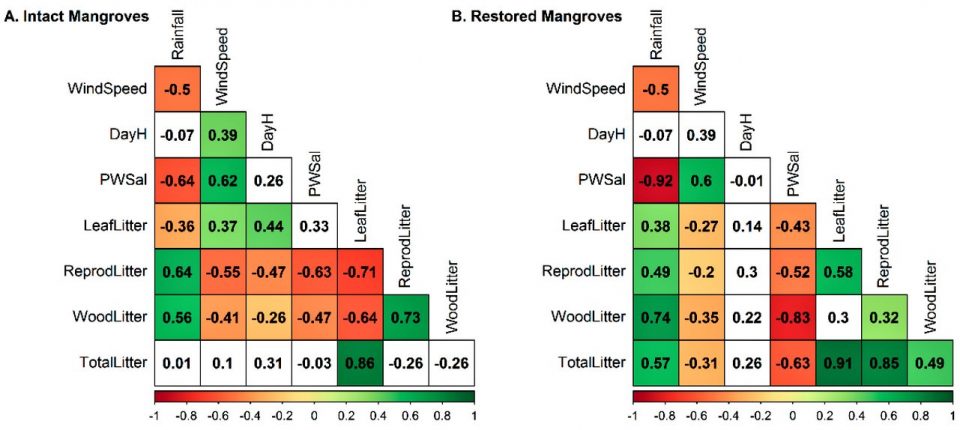
In restored mangroves, rainfall showed a positive correlation with total litterfall production and a negative correlation with porewater salinity. Total litter was negatively correlated with porewater salinity, in which wood litter had the highest association compared to other litter components. Along with increasing litter production, previous studies stated that higher salinities also cause a decrease in microbial respiration, thus suppressing decay rates and resulting in increased soil carbon stocks. Association of wind speed with litterfall was generally lower than intact forests, but all litter types along with total litter had a weak negative correlation. Compared to other climatic variables, monthly daylight hours had the weakest association with litter production in restored forests.
In alignment with our findings, rainfall is suggested to be the best climatic predictor of mangrove ecosystem carbon stocks. Other abiotic variables that affect the regulation of organic matter diagenesis are nutrient availability and porewater salinity. Porewater salinity is a major driver of mangrove productivity and spatial distribution due to the species-specific salinity tolerance of mangrove species. Seasonal variability of porewater salinity is influenced by the infiltration of inundated fresh water, water residence time, and water replacement dynamics, with porewater salinity levels similar to that of seawater during the dry season and to that of fresh water during the rainy season.
From our study, planting of Rhizophora spp. in abandoned ponds may contribute to the settlement of native mangrove seedlings by the above mechanisms, in which young Rhizophora stands act as the early successional vegetation in planted abandoned ponds and resulting in heterogeneous mangrove stands coexistence after >10 years of restoration program as displayed by their litterfall species composition in Figure 3. On the other hand, the structure of damaged pond walls in restored mangroves, which has a similar function to permeable breakwaters, may assist sediment accumulation and the establishment of mangrove seedlings in restoration sites.
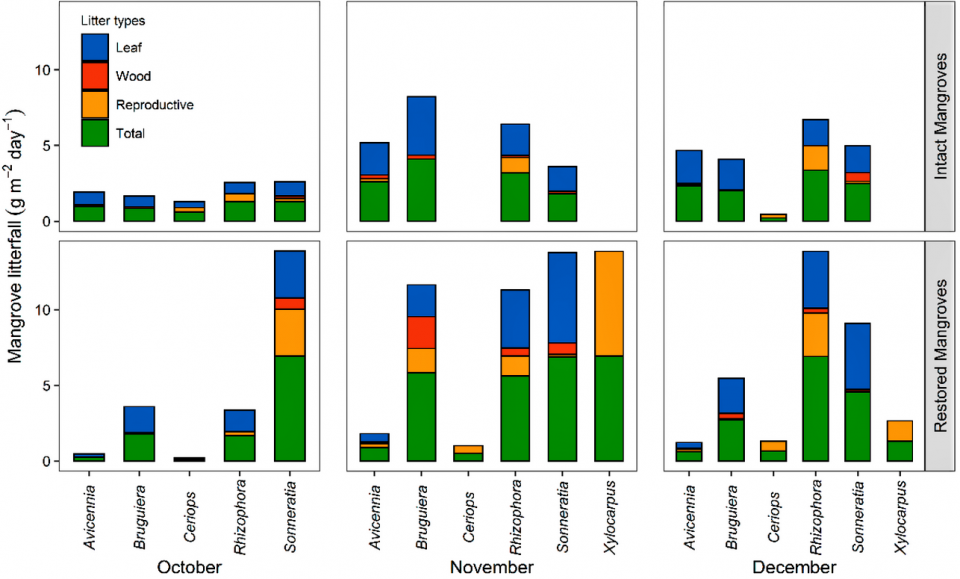
Leaf decomposition and associated macro-zoobenthos
In contrast to litterfall observation, there was no significant difference in leaf litter decay and decomposition between the two forest types; therefore it is suggested that these processes become more similar between restored and intact mangroves in recent years. Abiotic factors such as wind, temperature, moisture, rainfall, salinity, pH and tidal and current dynamics play a significant role in litter decomposition by stimulating the degradation processes. Frequent tidal flushing at the selected study sites is predicted to contribute to optimal physicochemical conditions for decomposition, resulting in an increased decay rate.
The similarity in macro-zoobenthic biodiversity indices between the two forest types was also observed, which rejects our hypothesis. Macro-zoobenthos epifauna and species composition in our study location were possibly connected with environmental condition parameters, similar to other findings from the Philippines and Sumatra Island, Indonesia. Macrobenthos diversity is influenced by the level of contamination in the substrate, the abundance of food sources, competition between and among taxa, the level of disturbance, and the condition of the surrounding environment.
Implications for mangrove conservation and restoration
Our study has important implications for mangrove restoration action, showing evidence of the recovery of mangrove forest productivity after restoration took place in abandoned aquaculture ponds. The restored mangroves with dense mangrove seedlings plantations currently appear to have a distinct young forest structure with high canopy cover and lower diversity of mangrove species compared to intact mangroves, which may explain the higher rate of litterfall production.
Over the years, the monoculture mangrove plantation site resembled a mixed mangrove forest, which can be identified with moderate to high canopy cover. But interestingly, the decomposition rates and macrozoobenthic biodiversity indices between restored and intact mangrove forests are alike. Mangrove litter production and decomposition has a substantial role in carbon sequestration, hence understanding its changes and differences is essential for predicting mangrove ecosystem services of global climate regulation from restoration programs.
The hydrology restoration in abandoned ponds by partial removal of pond walls in Perancak Estuary contributed to the establishment of mixed-species mangrove forests after ≥ 14 years of Rhizophora plantation by allowing the seedling transportation from existing mangrove stands as the seedling source to the ponds. The natural recruitment of other pioneer mangrove species like Avicennia and Sonneratia occurred in planting sites, suggesting a suitable biophysical condition for mangroves to colonize is already met. When mangrove planting in abandoned aquaculture ponds is performed in an area with no surrounding mangrove vegetation, we suggest that species diversity should be considered to enhance the succession of mangrove ecosystems in the targeted area.
Follow the Advocate on Twitter @GSA_Advocate
Now that you've reached the end of the article ...
… please consider supporting GSA’s mission to advance responsible seafood practices through education, advocacy and third-party assurances. The Advocate aims to document the evolution of responsible seafood practices and share the expansive knowledge of our vast network of contributors.
By becoming a Global Seafood Alliance member, you’re ensuring that all of the pre-competitive work we do through member benefits, resources and events can continue. Individual membership costs just $50 a year.
Not a GSA member? Join us.
Authors
-
Dr. Mohammad Basyuni
Corresponding author
Department of Forestry, Faculty of Forestry, Universitas Sumatera Utara, Medan 20155, Indonesia; and
Center of Excellence for Mangrove, Universitas Sumatera Utara, Medan 20155, Indonesia
-
Dr. Novia Arinda Pradisty
Institute for Marine Research and Observation, Indonesian Ministry of Marine Affairs and Fisheries Bali 82251, Indonesia; and
Research Center for Oceanography, National Research and Innovation Agency, Jakarta 14430, Indonesia -
Dr. Frida Sidik
Institute for Marine Research and Observation, Indonesian Ministry of Marine Affairs and Fisheries, Bali 82251, Indonesia; and
Research Center for Oceanography, National Research and Innovation Agency, Jakarta 14430, Indonesia -
Dr. Yuntha Bimantara
Department of Forestry, Faculty of Forestry, Universitas Sumatera Utara, Medan 20155, Indonesia
-
Dr. Ipanna Enggar Susetya
Center of Excellence for Mangrove, Universitas Sumatera Utara, Medan 20155, Indonesia
Tagged With
Related Posts
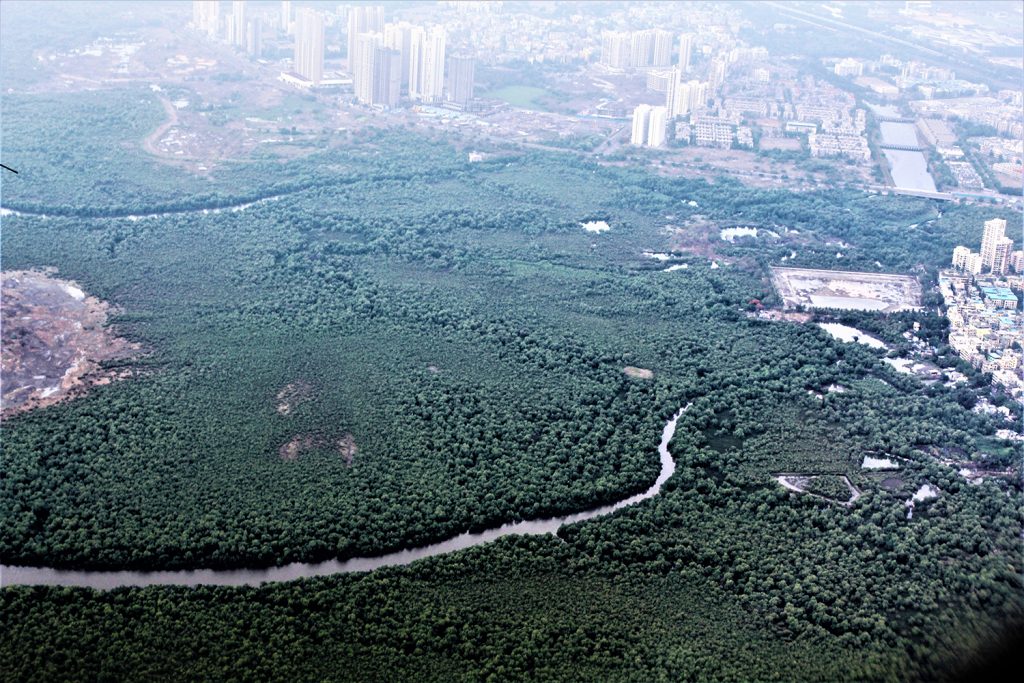
Responsibility
Modeling future carbon emissions from global mangrove forest loss
Developing a spatial model that projects emissions caused by mangrove forest loss to overcome current limitations in global estimations.
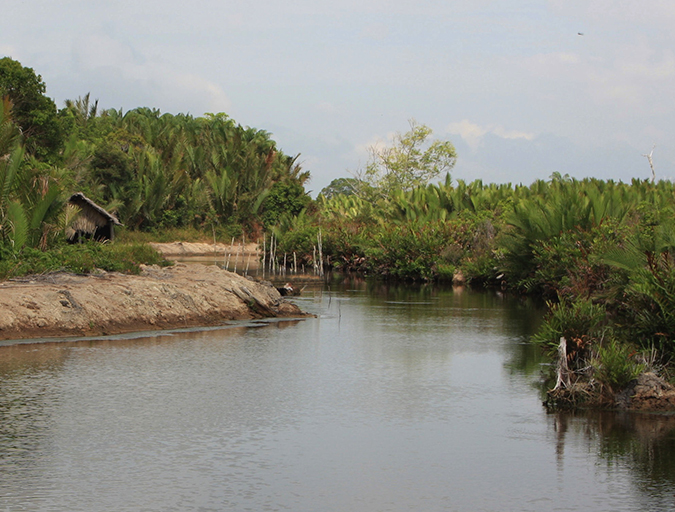
Intelligence
From forest to plate, a shrimp redefining ‘farmed’
The explosive growth of shrimp farming has long been associated with mangrove deforestation in Southeast Asia. A silvofishery method of producing the popular seafood is protecting the fragile ecosystems in Vietnam. A hungry marketplace is reaping the rewards.
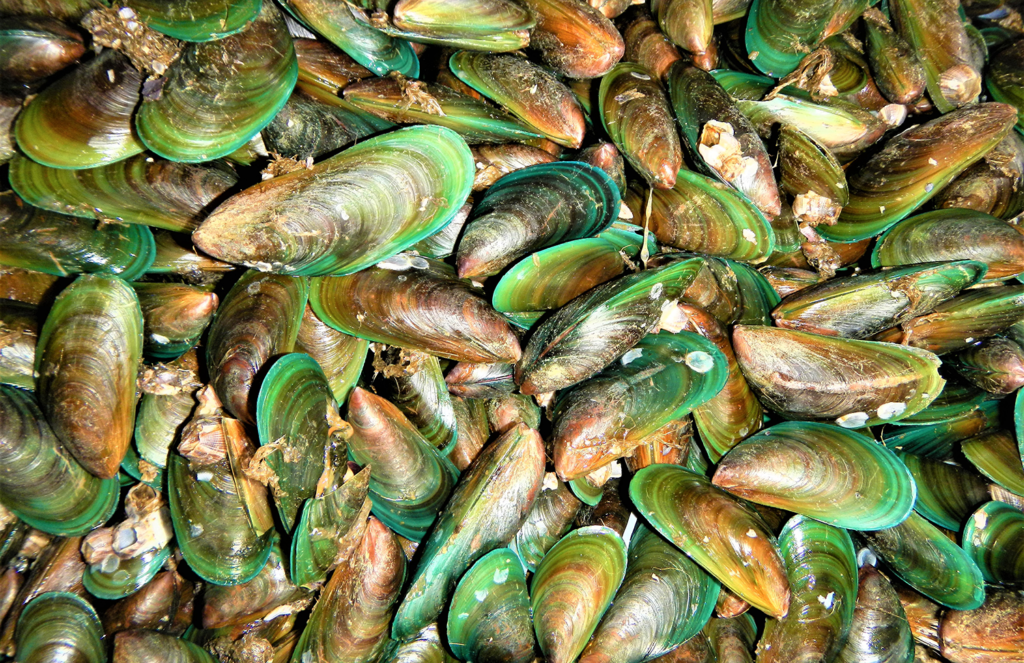
Responsibility
Green mussel culture using longlines and traditional stake methods in Indonesia
Study compares green mussel culture using longlines and the traditional bamboo stake method with different mussel densities in a rural area of Indonesia.
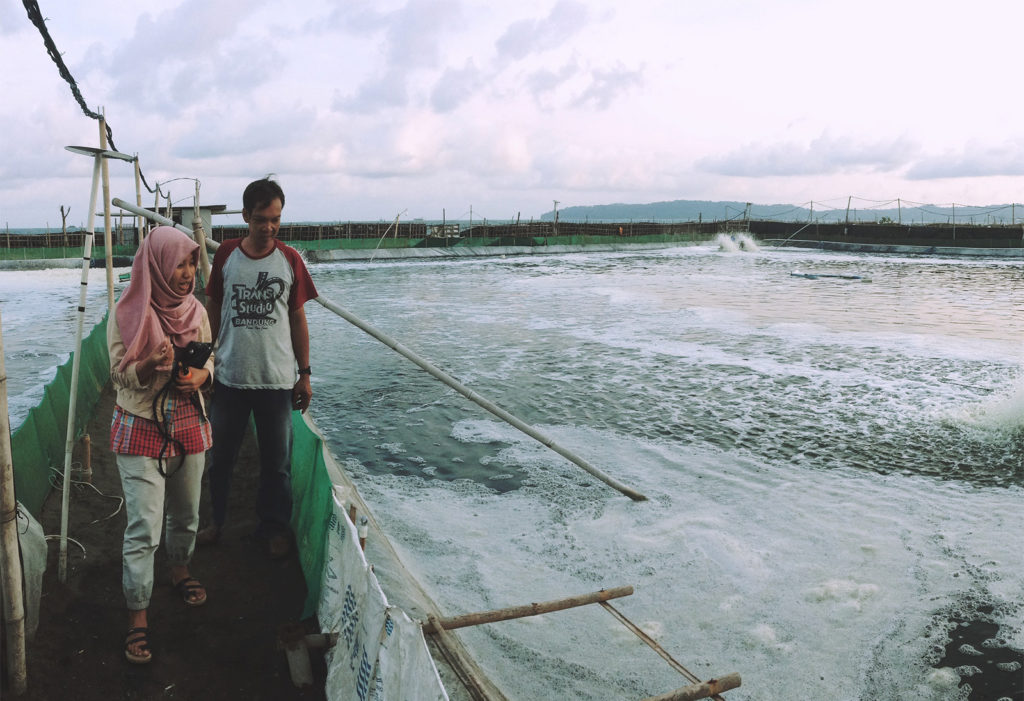
Innovation & Investment
JALA engineering innovation for Indonesian shrimp farmers
A company in Indonesia hopes the vast network of shrimp farms throughout the country will adopt its IoT device, particularly when they’re on the go.



